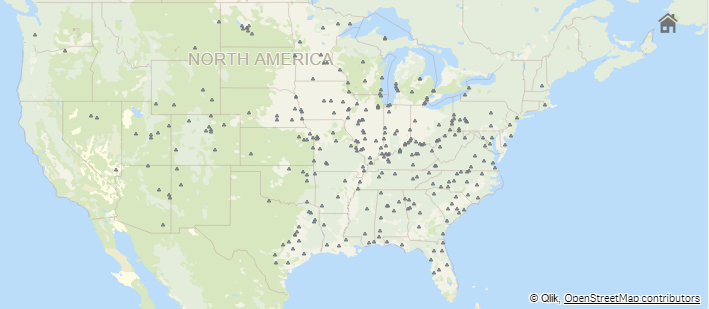Although it may not be a trending cocktail party topic, coal ash compliance activities are certainly well-known in the legal and environmental risk management community. Billions of dollars are at stake for the owners and operators of coal power plants impacted by the 2015 Disposal of Coal Combustion Residuals (CCR) rule.
Consider that there are 100+ organizations operating 300+ regulated sites with 700+ CCR units, and that the total amount of CCR material exceeds 2 billion cubic yards. If all surface impoundments and landfills were covered, the total area of the final cover is nearly 38,000 acres. Millions of public utility ratepayers have coal-generated power delivered to their homes, and although that percentage has been in decline as renewables and gas usage has increased, it is still a critical element of the U.S. power generation base.
 CCR site locations in the U.S.
CCR site locations in the U.S.The 2015 rule provides a comprehensive set of requirements for the safe disposal of CCRs. Individual facilities are responsible for implementing the standards under the rule. Given the myriad of stakeholders involved—from owners and operators, to state regulators, to NGOs, to consulting firms—all of whom are reporting, interpreting, supporting, and/or contesting the data and associated plans, it is no surprise that the self-implementing nature of the rule has presented a number of compliance challenges.
Navigating this complex and dynamic market is difficult for even the most sophisticated legal and engineering firms. Data concerning the regulatory status of each CCR unit is not centrally recorded. Rather, each owner/operator maintains its own website with all required regulatory reports. Manually gathering, analyzing, and summarizing this discrete data is complicated and arduous, and is nearly impossible for individual organizations who would need to wrangle the thousands of documents and literally hundreds-of-thousands of pages of information by themselves.
Fortunately, business intelligence (BI) applications can cut through the market complexities in extraordinary ways. Modern BI tools compile data from multiple disconnected data sources, making that data much easier to analyze. Users can navigate through data quickly and easily in a variety of combinations, informing stakeholders of new scenarios as they unfold. The tools also offer dozens of visualization formats, from simple tables and pie charts to more sophisticated statistical analysis. This can facilitate the assessment of current market conditions, prediction of behaviors and application of best practices, and benchmarking of responses, a vital service new to the market.
Applied consistently, BI tools can enable tremendous efficiencies. Analysis that would have once taken hours or days to complete can now be done in minutes or even seconds. And for consulting firms like AECOM, BI apps have become central to how firms communicate risk management options to their customers. For example, AECOM worked with business analytics and data engineering firm FirmoGraphs to customize their Ash Mart tool for the U.S. coal ash and CCR market. Using Ash Mart, AECOM can manipulate publicly available data in views for analysis and comparison, which informs clients’ discussions around engineering design, construction schedule, and closure options. The data can also be filtered, processed, and summarized in real time, replacing substantial manual analytic work. The tool can even feed into live presentations during which attendees may ask questions and see the results in real time.
Using BI applications like Ash Mart, CCR owners and operators can gain insight as to market trends. Access to market data allows utilities to benchmark against one another, which is useful when they are facing similar operating and compliance scenarios. This allows individual organizations, as well as groups of companies, to have a stronger and more efficient market response by understanding how utilities are approaching environmental liabilities in their structured capital responses. It further assists in comprehending related information to support public, legal, or internal intelligence. BI tools can shine a light on needed technological solutions to address emerging compliance challenges; for example, remedial approaches to address forseeable groundwater concerns. BI applications like Ash Mart can also summarize industry trends for larger and more complex situations, which then can be benchmarked against more focused responses within a utility or geography. Furthermore, because data is geo-located, generating maps using tools like Ash Mart is easy. This is particularly useful when organizations are seeking different mechanisms for the beneficial use of coal ash materials as they are removed under closure-by-removal plans. For example, AECOM has assisted customers in identifying the most-efficient transportation methods to bring coal ash to cement kilns where the material becomes an integral and useful part of the manufactured cement products.
AECOM has realized strong benefits from its deployment of BI tools and techniques and is evaluating additional ways that growing data literacy can benefit industrial and governmental customers. Stay tuned for a future blog on industry trends and actionable BI gleaned from our deployment of Ash Mart.


